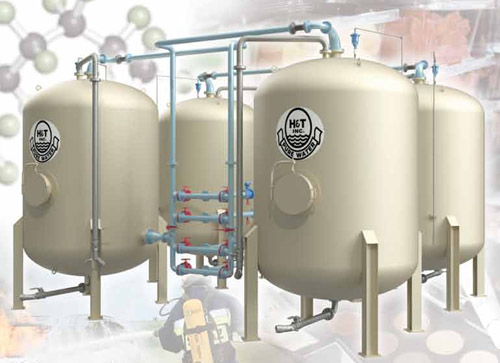Your Overview to PFAS Therapy Technologies and Perks
The frequency of PFAS contamination in water sources demands a complete understanding of readily available treatment innovations. Each innovation not just targets details PFAS substances yet also plays an important function in boosting total water quality and shielding ecological honesty.
Comprehending PFAS Contamination
Comprehending PFAS contamination is crucial for resolving its pervasive impact on environmental and human health and wellness (m270 pfas treatment). Per- and polyfluoroalkyl materials (PFAS) are a team of artificial chemicals commonly made use of in different commercial and customer items because of their water- and grease-resistant residential or commercial properties. Commonly discovered in firefighting foams, non-stick kitchenware, and water-repellent fabrics, PFAS have actually gotten in the setting via production processes, wastewater discharges, and leaching from landfills
Once released, these materials continue the environment, causing extensive contamination of soil and water sources. Their one-of-a-kind chemical framework, defined by strong carbon-fluorine bonds, renders them resistant to destruction, leading to a phenomenon called "for life chemicals." Consequently, PFAS can build up in the human body and the food cycle, possibly triggering damaging wellness impacts, consisting of body immune system disturbance, developing problems, and a raised threat of specific cancers.
Regulative agencies and health and wellness organizations are significantly recognizing the value of PFAS contamination, motivating initiatives to keep an eye on, evaluate, and minimize its effects. Recognizing the paths of PFAS contamination is necessary for informing public law and developing efficient strategies to secure both environmental and human health.
Review of Treatment Technologies
Various therapy technologies have actually been created to address the obstacles posed by PFAS contamination in water and soil. These modern technologies can be broadly categorized into numerous groups, each with its distinct systems and performance in removing PFAS compounds.
One noticeable strategy is ion exchange, which makes use of resin products to catch and get rid of PFAS from polluted water. One more innovation, advanced oxidation processes (AOPs), uses solid oxidants and ultraviolet light to damage down PFAS into less damaging substances.

Triggered Carbon Filtration
Triggered carbon filtration is a commonly used approach for the elimination of PFAS from infected water, understood for its ability to adsorb a wide variety of natural compounds. This modern technology uses activated carbon, a highly permeable product with an extensive surface area, which facilitates the binding of PFAS molecules with physical adsorption. The efficiency of triggered carbon in eliminating PFAS is influenced by several factors, including the kind of carbon made use of, the contact time, and the focus of PFAS in the water.
Among the advantages of activated carbon filtration is its versatility; it can be executed in different configurations, such as granular triggered carbon (GAC) systems or powdered triggered carbon (POLITICAL ACTION COMMITTEE) systems. GAC systems are commonly used in larger-scale applications, while special-interest group can be utilized in smaller or temporary arrangements. The innovation is fairly simple to run and preserve, making it accessible for several water treatment centers.

Ion Exchange Equipment
Ion exchange systems represent another reliable method for the elimination of PFAS from polluted water, complementing techniques like activated carbon purification. These systems operate on the principle of trading ions in the water with ions held on a resin product. Ion exchange materials can be particularly created to target the negatively billed PFAS compounds, properly catching them and permitting cleaner water to travel through.
One of the key advantages of ion exchange systems is their capability to remove a wide variety of PFAS, including both long-chain and short-chain versions. This convenience makes them suitable for different applications, varying from community water therapy to industrial processes. In addition, ion exchange systems can usually achieve reduced discovery limitations for PFAS contrasted to a few other treatment methods, thus boosting water quality.
Nonetheless, it is important to check and manage the regeneration of ion exchange media, as the performance can decline with time due to saturation. Proper upkeep and substitute of the material are important for maintaining the system's performance. Overall, ion exchange systems offer a reliable and efficient service for PFAS elimination, adding dramatically to safe drinking water requirements and ecological security.
Advanced Oxidation Processes
Advanced Oxidation Processes (AOPs) make use of effective oxidants to efficiently break down PFAS substances in infected water. These cutting-edge therapy approaches create very responsive varieties, such as hydroxyl radicals, that can damage down complicated PFAS particles right into much less unsafe results. m270 pfas treatment. AOPs commonly use mixes of ultraviolet (UV) light, ozone, hydrogen peroxide, or Fenton's reagent, boosting the image source oxidation possibility and boosting destruction performance
The key benefit of AOPs hinges on their ability to target a broad variety of PFAS compounds, consisting of both long-chain and short-chain variants. This versatility is important, as PFAS contamination frequently involves combinations of various substances with differing chemical frameworks. AOPs can be integrated right into existing water treatment systems, making them a useful remedy for lots of communities and markets.
Nevertheless, the application of AOPs can be resource-intensive, requiring mindful consideration of functional expenses and power consumption. In addition, while AOPs are reliable in breaking down PFAS, they might not completely remove all by-products, necessitating more treatment actions - m270 pfas treatment. Generally, AOPs represent an encouraging avenue for addressing PFAS contamination, adding to cleaner water resources and improved public health security

Verdict
By choosing the appropriate modern technology, communities can boost water high quality, safeguard public health, and mitigate the ecological threats connected with PFAS direct exposure. Continued study and implementation of these approaches are important for reliable management of PFAS contamination in impacted areas.